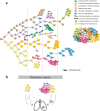Clinical implications of intratumor heterogeneity: challenges and opportunities
- PMID: 31970428
- PMCID: PMC7007907
- DOI: 10.1007/s00109-020-01874-2
Clinical implications of intratumor heterogeneity: challenges and opportunities
Abstract
In this review, we highlight the role of intratumoral heterogeneity, focusing on the clinical and biological ramifications this phenomenon poses. Intratumoral heterogeneity arises through complex genetic, epigenetic, and protein modifications that drive phenotypic selection in response to environmental pressures. Functionally, heterogeneity provides tumors with significant adaptability. This ranges from mutual beneficial cooperation between cells, which nurture features such as growth and metastasis, to the narrow escape and survival of clonal cell populations that have adapted to thrive under specific conditions such as hypoxia or chemotherapy. These dynamic intercellular interplays are guided by a Darwinian selection landscape between clonal tumor cell populations and the tumor microenvironment. Understanding the involved drivers and functional consequences of such tumor heterogeneity is challenging but also promises to provide novel insight needed to confront the problem of therapeutic resistance in tumors.
Keywords: Antitumor therapeutics; Artificial intelligence; Intratumor heterogeneity; Liquid biopsy.
Conflict of interest statement
The authors declare that they have no conflict of interest.
Figures



References
-
- Marusyk A, Almendro V, Polyak K. Intra-tumour heterogeneity: a looking glass for cancer? Nat Rev Cancer. 2012;12(5):323–334. - PubMed
Publication types
MeSH terms
LinkOut - more resources
Full Text Sources
Other Literature Sources
Medical

